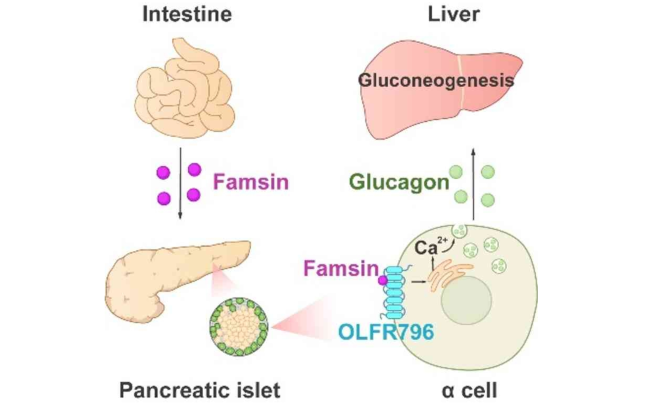Glucose homeostasis requires precise regulatory mechanisms to adapt to varying physiological conditions such as feeding, fasting, exercise, and stress. Glucagon, a hormone secreted by pancreatic α-cells, plays a crucial role in raising blood glucose levels during fasting. Despite being discovered over a century ago, the mechanisms underlying glucagon secretion have largely remained unclear—until now.
On December 19, 2024, a research team led by Professor Yiguo Wang from the School of Life Sciences at Tsinghua University, in collaboration with Professor Jiqiu Wang’s group at Ruijin Hospital, Shanghai Jiao Tong University School of Medicine, and Professor Zhuoxian Meng’s team from Zhejiang University School of Basic Medicine, published a paper in Cell Metabolism entitled “A Famsin-Glucagon Axis Mediates Glucose Homeostasis.” This study uncovers the critical role of the gut-derived hormone famsin in promoting glucagon secretion and maintaining glucose homeostasis.
Famsin, identified and named by Professor Yiguo Wang’s team, is a fasting-induced hormone secreted by the gut (Long et al., Cell Research, 2023, 33(4): 273-287). This hormone mobilizes energy by enhancing hepatic gluconeogenesis and ketogenesis and induces a torpor state via hypothalamic signaling, reducing energy expenditure and preserving energy during fasting.

Figure 1: Famsin promotes glucagon release and enhances hepatic gluconeogenesis.
The study demonstrates that famsin binds to its receptor, OLFR796 in mice (or OR10P1 in humans), triggering calcium release from the endoplasmic reticulum in pancreatic α-cells. This process stimulates glucagon secretion, which is essential for maintaining hepatic glucose production and blood glucose balance (Figure 1). Genetic analyses in mice and human cohorts reveal that excessive famsin signaling contributes to hyperglucagonemia in type 2 diabetes. Furthermore, rare variants in the human OR10P1 gene, such as rs1472465081 and rs140357644, result in premature protein termination, impairing famsin binding and significantly reducing glucagon secretion.
This research highlights the importance of gut-islet interorgan crosstalk mediated by the famsin-glucagon axis in glucose regulation during fasting. It also provides novel insights into the gut’s role in the pathogenesis of type 2 diabetes and identifies potential therapeutic targets for metabolic disorders.
Research Team and Funding Acknowledgments
Associate Professor Yiguo Wang (Tsinghua University), Professor Jiqiu Wang (Ruijin Hospital, Shanghai Jiao Tong University School of Medicine), and Professor Zhuoxian Meng (Zhejiang University School of Basic Medicine) are the corresponding authors of this study. Dr. Aijun Long, a former postdoctoral fellow at Tsinghua University and now an Associate Professor at Xiangya Second Hospital, Central South University, is the first author.
Significant contributions were made by Ph.D. student Yazhuo Wang (Tsinghua University), master’s student Yihua Guo, Professor Jie Hong, and Professor Guang Ning (Ruijin Hospital). The authors express their gratitude to Professor Xiao Yu (Shandong University), Professor Xiao Han, and Professor Tao Yang (Nanjing Medical University) for their valuable advice and support.
This research was funded by the National Natural Science Foundation of China, the Ministry of Science and Technology, the Tsinghua University Dushi Program, and the Tsinghua-Peking Center for Life Sciences.
Paper link:
https://www.cell.com/cell-metabolism/fulltext/S1550-4131(24)00454-6
Editor: Li Han

